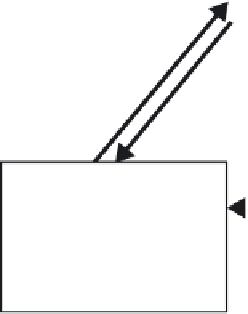Information Technology Reference
In-Depth Information
Figure 11.4
Applying CSE Theory to Practice
Behavior
Learning
Self-Regulation,
Adoption,
Problem Solving,
Performance
Person
Environment
Attributions,
Goal Orientation,
Computer
Self-Efficacy
Formal Training,
Post-Training
Support
The following section describes our current attempts to understand how CSE judgments are
formed, and how they influence behavior, by looking specifically at four contexts in which CSE
plays a role. We draw primarily upon our own ongoing research, but also incorporate other find-
ings that apply to the specific contexts, as a means of applying CSE theory to practice.
APPLYING CSE THEORY TO PRACTICE
Our ongoing programs of research adopt a holistic view of computer self-efficacy development by
examining various events within the lifecycle of computer usage such as formal training to self-
directed learning, new technology introductions, and everyday use. We are interested in understand-
ing the different environments in which people develop confidence in their abilities during these
events and in identifying the web of influences that drive CSE judgments across these different
domains. Formal training settings are often the first, and generally the most obvious, context in which
CSE is developed. But while formal training is an important place where CSE can be intentionally
influenced, it represents only a small portion of the learning undertaken by individuals. Self-regulated
learning is by far the more common means by which users learn (e.g., Nelson, 1991). Thus, we have
also examined how CSE develops in this context. Even when learning is not the primary goal of the
user, development of capability and CSE takes place. We also examined the development of CSE dur-
ing the introduction of new technology, specifically enterprise-wide information systems, and during
the resolution of technical problems with the aid of organizational support. The former represents a
situation where work and learning are being managed simultaneously, as individuals adjust to a new
technological domain while striving to maintain their task performance. The latter represents a situa-
tion where a technological problem during task performance has resulted in an inability to complete
the task and where learning may be necessary to resolve the problem. Figure 11.4 depicts this theo-
rizing within the framework of triadic reciprocality. Attributions, goal orientation, and self-regulation
are seen as individual cognitions and factors influencing computer self-efficacy. Problem solving and
self-regulated learning activities are seen as behaviors that influence computer self-efficacy, while
learning, adoption, and performance are seen as behaviors that are influenced by computer self-
efficacy. Environmental influences stem from the contexts of the various research streams, including
attributes of formal training and post-training support provided to the individual.











Search WWH ::

Custom Search